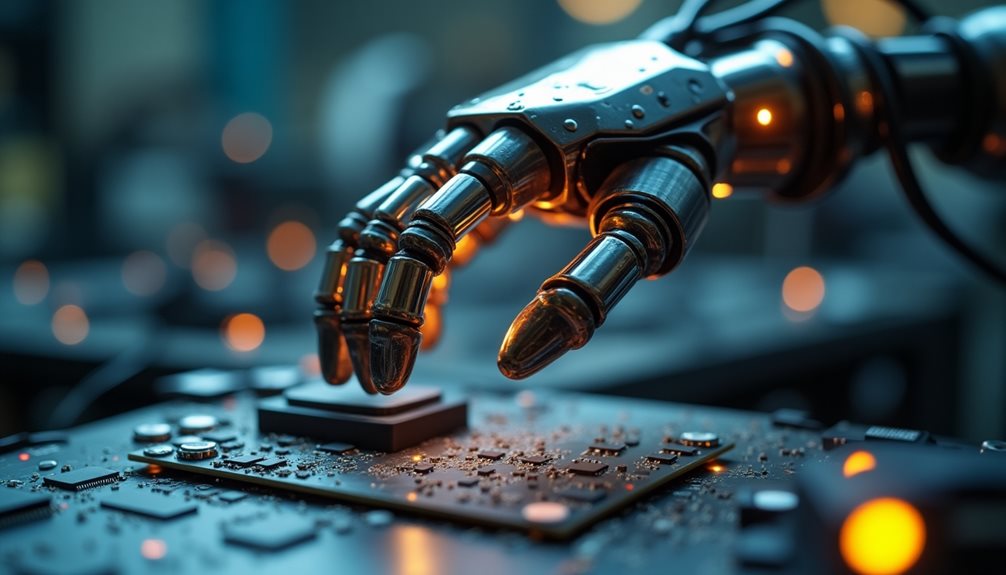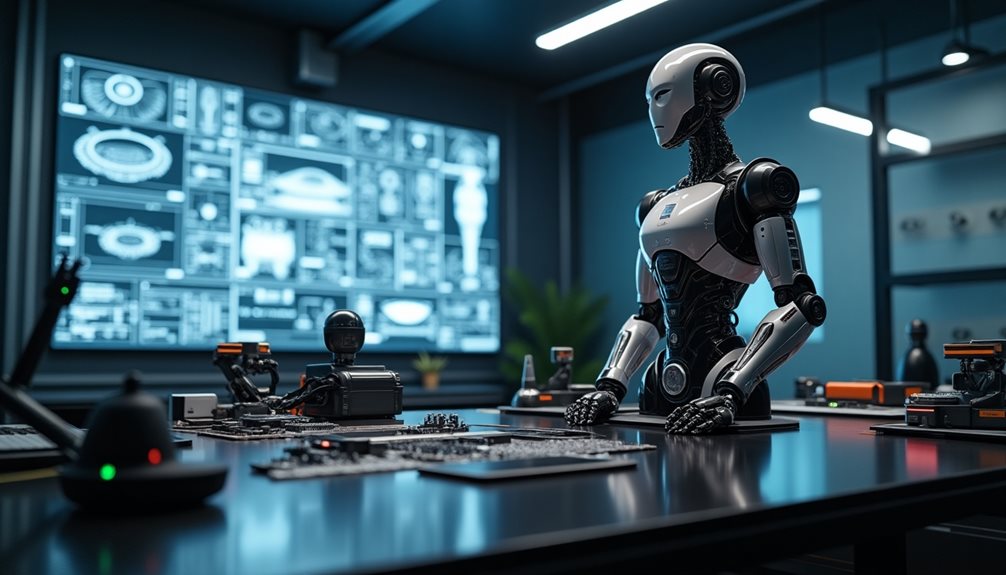Mastering robotics and automation vocabulary in Russian is essential for professionals in the field. Key terms such as “робот” and “автоматизация” form the foundation for effective communication. Familiarity with these concepts can greatly enhance collaboration and project execution. In addition, understanding technical specifications and engaging with experts requires a deeper grasp of the language. As the industry evolves rapidly, so too does the need for precise terminology. This raises important questions about ongoing developments and their implications.
Table of Contents
ToggleEssential Robotics Terms in Russian

In the domain of robotics, understanding key terminology is essential for effective communication and collaboration.
Essential robotics terms in Russian facilitate a deeper comprehension of robotics applications and automation trends within the industry. As robotics technology advances and integrates more deeply into industries such as manufacturing, healthcare, logistics, and service sectors, familiarity with the relevant vocabulary in Russian helps professionals communicate clearly and collaborate effectively within Russian-speaking environments or with Russian partners.
The foundation of robotics vocabulary includes basic but powerful terms:
- Робот (Robot) — A machine capable of carrying out complex actions automatically, often programmable to perform a variety of tasks.
- Автоматизация (Automation) — The process of using technology to perform tasks without human intervention, widely applied in industrial production and other areas.
- Искусственный интеллект (Artificial Intelligence) — The simulation of human intelligence processes by machines, especially computer systems, enabling robots to learn, reason, and adapt.
- Манипулятор (Manipulator) — A robotic arm or device designed to interact with objects, often used in manufacturing or surgery.
- Датчик (Sensor) — A device that detects changes in the environment and sends information to the robot’s control system.
- Программирование (Programming) — The act of writing code or instructions that direct a robot’s behavior.
- Автоматический режим (Automatic mode) — Operating mode where the robot functions autonomously based on pre-set instructions or AI algorithms.
- Механизм (Mechanism) — The physical components and structures that enable movement and function within the robot.
- Навигация (Navigation) — The capability of a robot to determine its position and move through an environment.
- Обработка данных (Data processing) — The analysis and interpretation of data collected by sensors for decision-making.
- Кибернетика (Cybernetics) — The interdisciplinary study of control and communication in animals, humans, and machines; closely related to robotics.
In addition to these terms, it is helpful to know phrases that describe the broader context and applications of robotics:
- Промышленные роботы (Industrial robots) are widely used for tasks like welding, assembling, and painting, increasing productivity and safety.
- Сервисные роботы (Service robots) assist humans in areas such as cleaning, delivery, and healthcare.
- Автономные роботы (Autonomous robots) operate independently without human control, using AI and sensors to perform tasks.
- Робототехнические системы (Robotic systems) refer to integrated setups combining hardware and software for specific functions.
Understanding the Russian terminology related to robotics supports professionals in areas such as research, development, manufacturing, and education. It also facilitates keeping up with the latest trends in automation and artificial intelligence within Russia and other Russian-speaking regions.
This linguistic competence not only improves technical communication but also promotes innovation by enabling better exchange of ideas and collaboration across borders. The global nature of robotics means that knowing how key concepts translate into Russian broadens access to scientific literature, patents, market opportunities, and training materials.
In summary, mastering essential robotics terms in Russian equips individuals with the tools to navigate the fast-evolving world of automation with confidence and clarity. It bridges technical gaps and fosters effective teamwork in a field defined by rapid technological progress.
Key Automation Vocabulary
Automation plays a pivotal role in modern robotics, and understanding key terminology is essential for anyone involved in the field. Key terms related to automation processes include “sensors,” which detect changes in the environment, and “actuators,” which enable movement.
“Control systems” are essential for managing robotic functions, ensuring precision in robotics applications. Additionally, “feedback loops” are significant for monitoring performance and making real-time adjustments.
Concepts such as “machine learning” emphasize the importance of adaptability in automation processes, allowing robots to improve over time. Familiarity with these terms not only enhances communication among professionals but also supports innovation in the robotics sector.
Automation is a crucial part of modern robotics. For English speakers learning Russian, it’s helpful to understand both the English terms and their Russian equivalents. Below is an expanded explanation of key automation terms, along with a list of related Russian words. This will help learners connect the concepts in both languages.
![]()
Explanation of Key Terms
- Sensors (Датчики): Devices that detect changes in the environment like temperature, light, or movement. For example, a sensor in a robot might detect obstacles to avoid collisions.
- Actuators (Исполнители): Components that cause movement or actions. For example, motors that move robot arms are actuators.
- Control Systems (Системы управления): These systems manage the operations of a robot, ensuring tasks are performed accurately. For example, a control system might regulate the speed and direction of a robot.
- Feedback Loops (Циклы обратной связи): Processes where the system monitors its own performance and makes adjustments in real time. For example, a feedback loop helps a robot correct its position if it deviates from a path.
- Machine Learning (Машинное обучение): A method that allows robots to learn and improve from experience without being explicitly programmed for every task.
![]()
Related Russian Terms Table
| Russian (Cyrillic) | English Phonetic | English Definition |
|---|---|---|
| Автоматизация | Avtomatizatsiya | Automation |
| Датчик | Datchik | Sensor |
| Исполнитель | Ispolnitel | Actuator |
| Система управления | Sistema upravleniya | Control system |
| Цикл обратной связи | Tsikl obratnoy svyazi | Feedback loop |
| Машинное обучение | Mashinnoe obuchenie | Machine learning |
| Робот | Robot | Robot |
| Алгоритм | Algoritm | Algorithm |
| Программирование | Programmirovanie | Programming |
| Датчик температуры | Datchik temperatury | Temperature sensor |
| Электродвигатель | Elektrodvigatel | Electric motor |
| Управление движением | Upravlenie dvizheniem | Motion control |
This vocabulary will help English speakers not only understand automation concepts but also communicate more effectively in Russian when discussing robotics and automation technology.
Commonly Used Phrases in Robotics
Understanding commonly used phrases in robotics is crucial for clear and effective communication within the field. Robotics is a multidisciplinary area that combines mechanical engineering, electrical engineering, computer science, and artificial intelligence. Professionals working in this domain frequently use specific terms that convey precise meanings about technology, processes, and challenges.
Key Phrases Related to Robotics Applications
- Robotic Process Automation (RPA):
RPA refers to the use of software robots or “bots” to automate repetitive, rule-based tasks typically performed by humans. Unlike physical robots, RPA operates at the software level to streamline business processes such as data entry, invoice processing, and customer service. It improves efficiency, reduces errors, and frees up human workers for more complex tasks. - Machine Learning Integration:
Machine learning (ML) integration in robotics involves embedding algorithms that allow robots to learn from data and improve their performance over time without explicit programming for every scenario. This integration is essential for tasks like object recognition, path planning, and adaptive control systems, enabling robots to operate in dynamic and unpredictable environments.
Phrases Addressing Automation Challenges
- System Integration:
This term describes the process of linking different subsystems or components—such as sensors, actuators, controllers, and software—to function together as a unified robotic system. Effective system integration ensures smooth communication between hardware and software elements, which is critical for reliable robot performance. - Sensor Calibration:
Sensors are essential for robots to perceive their environment. Calibration refers to adjusting sensors to provide accurate and consistent data. Proper sensor calibration accounts for noise, drift, and environmental variations, improving robot precision in tasks such as navigation, object detection, and manipulation.
Importance of Standardized Terminology
Using standardized terminology across teams and disciplines enhances understanding of project goals and expected outcomes. It helps avoid misunderstandings during design, development, testing, and deployment phases. For example, when engineers discuss “kinematics” or “actuator torque,” everyone shares a common interpretation of these technical concepts.
Mastering these phrases empowers professionals to navigate the complexities of robotics projects more efficiently. It supports collaboration between engineers, developers, researchers, and stakeholders from diverse backgrounds. Ultimately, a shared vocabulary contributes to faster innovation cycles and more successful robotics solutions in industries like manufacturing, healthcare, logistics, and autonomous vehicles.
![]()
Understanding Technical Specifications
Understanding technical specifications is essential for the successful design, development, and deployment of any robotics project. These specifications serve as a detailed blueprint, outlining the fundamental parameters and requirements that ensure the robotic system functions efficiently, reliably, and safely throughout its lifecycle. A deep understanding of these technical aspects is crucial for engineers (инженеры), developers (разработчики), and all stakeholders (заинтересованные стороны) involved in the project.
Power Supply (Питание)
The power supply defines the voltage range (диапазон напряжения) and current capacity (токовая емкость) required to energize all components of the robot. Selecting the appropriate battery type, such as lithium-ion (литий-ионный аккумулятор) or nickel-metal hydride (NiMH, никель-металлгидридный аккумулятор), is a key decision. Different operational modes impact power consumption (энергопотребление), with active movement or sensor operation drawing more current than standby modes. Backup power systems (резервные источники питания) might be included to prevent interruptions during critical tasks. Efficient power management (управление питанием) not only extends operational time but also protects sensitive electronics from damage due to voltage spikes or electrical faults (электрические неисправности).
Dimensions (Габариты)
Physical size and weight constraints influence how a robot moves and where it can operate. Dimensions typically include length (длина), width (ширина), and height (высота). Robots designed for confined indoor environments, such as service robots or robotic arms on assembly lines, must have compact dimensions (компактные размеры) to maneuver effectively. Weight (вес) affects both mobility and power requirements; heavier robots may need more powerful motors and stronger structural components but can also carry larger payloads. Additionally, transportability (транспортируемость) is an important consideration for mobile robots intended to be moved between sites.
Communication Protocols (Протоколы связи)
Communication protocols dictate how data is exchanged between internal components like sensors and actuators, as well as between the robot and external control systems. Common internal protocols include UART (универсальный асинхронный приемопередатчик), SPI (последовательный периферийный интерфейс), and I2C (интер-интегральная схема). For wireless communication, standards such as Wi-Fi, Bluetooth, and Zigbee are widely used, each offering different ranges, speeds, and power consumption levels. The choice of protocol affects not only data transfer speed (скорость передачи данных) but also reliability (надежность), security (безопасность), and interoperability (совместимость) with other devices.
Sensor Specifications (Характеристики датчиков)
Robots rely heavily on sensors to perceive their environment. These may include cameras (камеры), LIDAR (лазерное сканирование), ultrasonic sensors (ультразвуковые датчики), and infrared sensors (инфракрасные датчики). Each type has specific parameters such as sensitivity (чувствительность), detection range (дальность обнаружения), resolution (разрешение), and accuracy (точность). High-precision sensors enable better navigation and object recognition but often come with higher costs and increased energy use. Calibration (калибровка) ensures sensor data remains accurate over time, while environmental robustness (устойчивость к окружающей среде) ensures reliable operation under varying conditions like dust, moisture, or temperature changes.
Safety Standards (Стандарты безопасности)
Compliance with safety standards is mandatory to protect users and equipment. This includes meeting electrical safety certifications such as CE (СЕ маркировка) or UL (Underwriters Laboratories), implementing mechanical safeguards like protective covers or emergency stop buttons, and incorporating software fail-safes that detect malfunctions and halt operations if needed. Safety considerations cover both physical injury prevention and cyber-security aspects to protect against unauthorized access. Adherence to these standards is not only a legal requirement but also essential for gaining public trust in robotic technologies.
Additional Insights:
- Technical specifications act as a communication tool among multidisciplinary teams, ensuring everyone works toward the same goals.
- Clear documentation of specifications reduces development risks by identifying potential problems early.
- Advances in battery technology, wireless communication, and sensor miniaturization continuously reshape these specifications.
- Understanding trade-offs between performance, cost, and complexity is critical for optimizing the final robotic system.
This detailed understanding of technical specifications forms the foundation for creating robotics systems that are practical, safe, and effective across various applications.
Engaging With Experts: Conversational Phrases
Effective communication with experts in robotics is fundamental for successful collaboration and project outcomes. Engaging in meaningful conversations requires specific phrases that resonate within the field.
Professionals should express interest in the latest robotics innovations and inquire about ongoing automation trends. Phrases like “Can you elaborate on the impact of this innovation?” or “What automation trends are shaping the industry right now?” can prompt insightful discussions.
Additionally, showing appreciation for their expertise with statements such as “Your insights are invaluable for our project” fosters a positive dialogue. Utilizing these conversational phrases not only enhances understanding but also builds relationships that are essential for maneuvering the complex landscape of robotics and automation.
Communicating effectively with experts in robotics requires not only understanding the technical content but also using the right phrases that show interest, respect, and curiosity. For English speakers learning Russian, mastering these phrases will help build rapport and facilitate meaningful conversations in the field of robotics and automation.
Key Phrases to Use When Talking to Robotics Experts
- Expressing Interest in Innovations
- “Можете подробнее рассказать о влиянии этой инновации?”
Mozhete podrobnee rasskazat’ o vliyanii etoy innovatsii?
(Can you elaborate on the impact of this innovation?)
- “Можете подробнее рассказать о влиянии этой инновации?”
- Inquiring About Industry Trends
- “Какие тенденции автоматизации сейчас формируют отрасль?”
Kakie tendentsii avtomatizatsii seychas formiruyut otrasl’?
(What automation trends are shaping the industry right now?)
- “Какие тенденции автоматизации сейчас формируют отрасль?”
- Showing Appreciation for Expertise
- “Ваши знания бесценны для нашего проекта.”
Vashi znaniya bestseny dlya nashego proekta.
(Your insights are invaluable for our project.)
- “Ваши знания бесценны для нашего проекта.”
- Encouraging Detailed Explanation
- “Не могли бы вы объяснить это подробнее?”
Ne mogli by vy obyasnit’ eto podrobnee?
(Could you explain this in more detail?)
- “Не могли бы вы объяснить это подробнее?”
- Asking for Recommendations
- “Что вы порекомендуете для улучшения этой системы?”
Chto vy porekomenduyete dlya uluchsheniya etoy sistemy?
(What would you recommend to improve this system?)
- “Что вы порекомендуете для улучшения этой системы?”
- Requesting Opinions on Challenges
- “Какие основные вызовы вы видите в этой технологии?”
Kakie osnovnye vyzovy vy vidite v etoy tekhnologii?
(What are the main challenges you see in this technology?)
- “Какие основные вызовы вы видите в этой технологии?”
Related Russian Terms for Robotics and Automation
| Russian (Cyrillic) | English Phonetic | English Definition |
|---|---|---|
| Робототехника | Robototekhnika | Robotics |
| Автоматизация | Avtomatizatsiya | Automation |
| Инновация | Innovatsiya | Innovation |
| Тенденция | Tendentsiya | Trend |
| Технология | Tekhnologiya | Technology |
| Система | Sistema | System |
| Проект | Proekt | Project |
| Эксперт | Ekspert | Expert |
| Вызов | Vyzov | Challenge |
| Знания | Znaniya | Knowledge |
| Описание | Opisaniye | Description |
| Улучшение | Uluchsheniye | Improvement |
| Отрасль | Otrasl’ | Industry |
Using these phrases and terms will help English speakers engage more confidently with Russian-speaking professionals in robotics, making conversations more productive and respectful.
Frequently Asked Questions
What Resources Are Available for Learning Robotics Vocabulary in Russian?
Various resources exist for learning specialized vocabulary, including online learning platforms and vocabulary flashcards. These tools enhance understanding and retention, empowering individuals to master essential terms effectively and expand their knowledge in the field.
How Do I Find Native Speakers to Practice Robotics Terminology?
To find native speakers for conversation practice, one can explore community groups, or online forums. Engaging with individuals passionate about robotics fosters language skills while sharing knowledge in an open, collaborative environment.
![]()
What Are the Best Dictionaries for Technical Terms in Russian?
The best dictionaries for technical terms in Russian include extensive technical dictionaries and specialized glossaries. These resources facilitate accurate translations and understanding of complex terminology across various fields, promoting clarity and effective communication in specialized subjects.
Can I Find Robotics Communities Online That Use Russian?
Numerous online groups and Russian forums exist where enthusiasts and professionals share knowledge about robotics. These platforms facilitate collaboration, discussions, and networking, allowing individuals to connect and exchange ideas in their native language.



